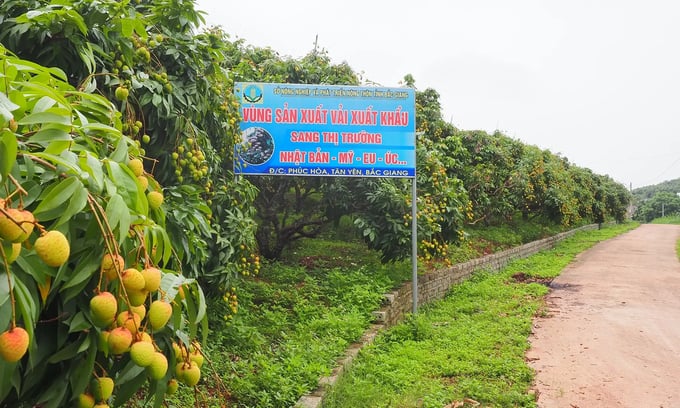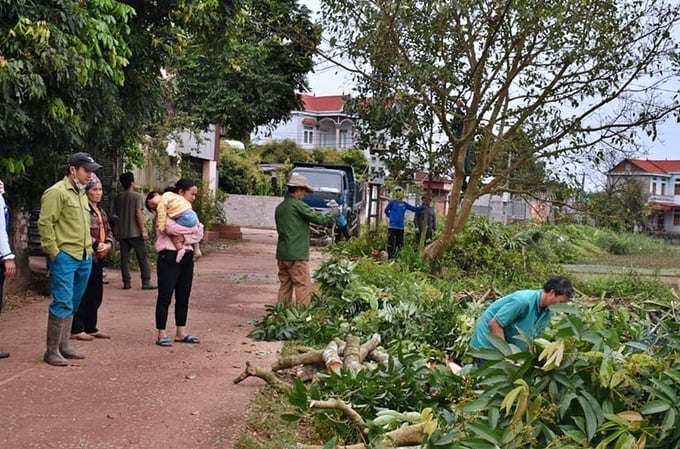November 27, 2025 | 01:27 GMT +7
November 27, 2025 | 01:27 GMT +7
Hotline: 0913.378.918
November 27, 2025 | 01:27 GMT +7
Hotline: 0913.378.918

Early-ripening lychee region in Phuc Hoa commune, Tan Yen district, Bac Giang province. Photo: Hoang Minh.
With support from the government and the local community, the Party Committee and the local government of Phuc Hoa commune have mobilized its residents to participate in land clearance, land donation, and property contribution for road construction without receiving financial support or compensation from the central budget since March 11.
At the time of writing, 67 households in the villages along the road have donated over 10,500 square meters of land and crops, in addition to 100 square meters of fencing and nearly 1,000 plants of multiple varieties.
Mr. Ngo Xuan Tuyen from Quat Du 2 village shared that the construction of a spacious and elegant road will greatly benefit the local residents. As a result, Mr. Tuyen and his neighbors joined in the effort as soon as the local government began mobilization.
On the commencement day, Phuc Hoa commune mobilized local self-defense militia forces, officials, civil servants and a large number of residents to participate in land clearance, tree felling, etc., to promptly hand over the cleared land to the contractor.
Phuc Hoa commune is considered a key early-ripening lychee area in Tan Yen district, and in Bac Giang province as a whole. The commune currently houses approximately 700 hectares of lychee farms, accounting for approximately two-thirds of the total area of Tan Yen district. With advantages in terms seasonality and quality, Phuc Hoa early-ripening lychees are widely preferred by businesses and consumers, typically resulting in higher prices than that of the main-crop lychees.
Approximately 15 hectares of early-ripening lychees in Phuc Hoa commune met GlobalGAP standards in 2023, which is required to export to demanding markets around the world such as Japan, the United States, and the European Union.

Local residents participating in land clearance activities in the early-ripening lychee region. Photo: Tan Yen District People's Committee.
According to Mr. Ngo Van Tiep, Chairman of Phuc Hoa Commune People's Committee, the expansion and upgrading of roads leading to the villages of Quat Du 2, Phuc Le, and Lan Thinh, which are the key areas for early-ripening lychee production, play a crucial role in assisting local residents market and promote this specialty fruit.
In addition to road improvements in the lychee production area, Phuc Hoa commune also aims to expand several key routes, inter-communal and intra-communal transport networks in 2024.
It is estimated that the commune's local government and residents will complete approximately 5 kilometers of road in 2024. The remaining 5 kilometers will be completed by June 2025.
Phuc Hoa commune is one of the six communes in Tan Yen district to meet the advanced new rural standards, along with Viet Lap, Hop Duc, Ngoc Chau, Phuc Son, and Que Nham. According to the District People's Committee, at least 80 billion Vietnamese dong will be allocated to further expand this list. Accordingly, 38 billion Vietnamese dong will be sourced from the central budget, and the remainder from provincial, district, commune budgets, and other funding sources.
The district will focus on planning, healthcare, culture, education, environment, and rural clean water in 2024, with the aim of qualifying for the advanced new rural district status by 2025.
Mr. Nguyen Viet Toan, Chairman of the Tan Yen District People's Committee, stated that the production value per hectare of local production land has rapidly increased over the years, reaching over 150 million Vietnamese dong annually. In addition, the average income per capita in rural areas has nearly tripled compared to that of 2011.
The district maintains production in 78 concentrated commodity production areas. In addition to its advantages, Tan Yen district currently prioritizes expanding its production area with a focus on high-value economic crops and processed fruits and vegetables such as sweet corn, peanuts, cantaloupes, Korean pears, cucumbers, and chili peppers.
Translated by Nguyen Hai Long
/2025/11/26/4909-2-154329_878.jpg)
(VAN) Pearl grouper farming in HDPE cages not only delivers economic efficiency but also contributes to protecting the environment, creating jobs, and promoting marine-based experiential tourism.

(VAN) The model of making a living under the forest canopy through the agroforestry system in Van Son commune, Bac Ninh province, is expected to generate an annual income of approximately VND 30 million/ha.

(VAN) Many enterprises in Can Tho are harnessing natural energy and reducing greenhouse gas emissions in their production processes, thereby contributing to the promotion of a sustainable green transition.
/2025/11/24/3536-2-112800_176.jpg)
(VAN) Dong Nai now has tens of thousands of hectares of forests certified for sustainable management, and this area will continue to be expanded in the coming period.

(VAN) Vinh Ha hamlet (Dai Xuyen commune, Hanoi) is shifting away from small-scale farming as households adopt bioscurity into their breeder chicken models.

(VAN) Heavy rains make aquatic species more vulnerable to disease. Proactive water management and high-tech systems help farmers prevent outbreaks and protect yields.

(VAN) Greenhouses are shifting production mindsets in Binh Lu commune, enabling farmers to ‘weather the sun and rain’ and secure stable vegetable harvests throughout the year.